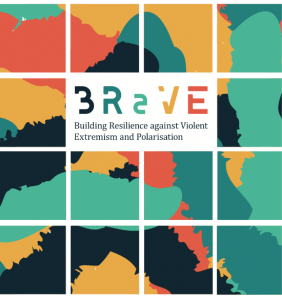This Blog post is the first in a four-part series of article summaries from the EU H2020-funded BRaVE project’s First Monday Special Issue exploring societal resilience to online polarization and extremism. The second is HERE. Read the full article HERE [Ed.].
By Inés Bolaños Somoano
This post synopsises my article ‘The right-leaning be memeing: Extremist uses of Internet memes and insights for CVE design’, which appears in a just-released special issue of the open access Internet journal First Monday. The special issue, titled ‘Exploring societal resilience to online polarization and extremism’, is an output of the EU-funded BRaVE research project.
‘The right-leaning be memeing’ aims to map current knowledge on the use of Internet memes in online extreme-right milieus, in order to establish a theoretical baseline for incorporating Internet memes into future Countering Violent Extremism (CVE) programmes.
In doing so the article covers four main areas of study. Firstly, it looks at existing literature on memes as communication units. Secondly, it looks at the particular ways in which transnational extreme-right groups use Internet memes. Thirdly, it discusses the applicability of these memes to resilience-building projects targeting the extreme right. Finally, the article’s conclusions discourage the use of Internet memes by state and security actors, while putting forward positive uses by other actors.
The literature review attempts to fill a gap in research and policy responses to the cultural and social aspects of online right-wing milieus. It chooses to focus on Internet memes because they are a key element of the online communications and identity formation processes of young people today, and play a role—however unclear—in online radicalisation.
Humour appears to be the key component of Internet memes. The particularly digital extreme right milieu fully exploits humour for its purposes. First, humour serves as a vehicle for disseminating political messages more effectively, mixing a humorous tone with visually attractive elements from pop culture. In social media, “memetic content is repeatedly deployed to promote extremist narratives under the guise of pop-cultural aesthetics, humour, and irony, thus lowering the barrier for participation”.
Secondly, while some memes explicitly promote violence or extremist narratives, others are softer or more ‘contextual’, meaning that they take on extremist connotations only when situated within a broader extremist context. Interpreting memes requires some level of digital literacy and a knowledge of the extreme right—indeed, the more extreme Internet memes may perhaps be designed solely for collective participatory platforms like 4chan or Reddit, which have well-established right-wing networks familiar with the codes and eager to keep non-believers out.
Conversely, softer memes are meant for mainstream social media platforms, which tend to ban or remove obviously violent, graphic or threatening content, and target a wider audience. Internet memes may thus be inferred to serve gate-keeping functions and act as in-group/out-group dynamic markers, as well as being a clever way of avoiding content moderation tools.
This leads to the third and perhaps most important way in which Internet memes are exploited by extreme-right groups: to facilitate the whitewashing of violence. Existing research points to this, arguing that memes are a key aspect of online culture for the far right as they may lower the barrier for participation in extreme ideologies by using humour to mask overtly racist narratives.
Countering right-wing extremism
We must acknowledge an inherent tension in even considering how to adapt Internet memes for CVE campaigns. Memes are basically very effective communication units, popular among highly digitalised individuals who are part of transnational networks. CVE programmes, on the other hand, tend to be hyper-localised in geographical terms, in their efforts to focus on creating resilient individuals or communities and counter the influence of extremist propaganda and narratives. This conceptualization of CVE clashes fundamentally with the uses of Internet memes. In stark contrast to CVE practices, which are emphatically local in theory and practice, intolerance, hate speech and right-wing extremism are not restricted by national borders, but operate transnationally.
Another important aspect to consider is that there are potentially massive counterproductive effects for state and civil actors engaging in a ‘meme war’ with the largely transnational and digitally competent groups that compose online right-wing milieus. The biggest obstacles to state and social actors wishing to use memes are cultural articulation and legitimacy.
Memes often reference pop culture and draw humorous inspiration from problems common to a certain audience. The sense of legitimacy conferred by the user origin of Internet memes is also key, as there is a widespread (if incorrect) perception that memes are made ‘by users, for users’: they carry an assumption of egalitarian origin. Both these aspects are largely lost when Internet memes are employed by, for example, a Ministry of Interior or a large international organisation, who are responsible for funding or implementing most CVE campaigns in Europe.
A crucial takeaway from the literature on online right-wing culture is that we should not trivialise or minimise far-right youth anger, as both “cultural and emotional rationales for extremist engagement” should be taken equally seriously. Indeed, this advice echoes that of established CVE/EXIT projects in the EU, such as EXIT Europe and U-Turn, which highlight the importance of taking young people’s grievances seriously, improving their relationship with state authorities and conducting programmes in the most localised way possible so as to avoid the stigmatisation of innocent communities and/or individuals.
The same approach should be taken online when using Internet memes as vehicles for countering online extremist activity. It is crucial for aspiring users of Internet memes to define who creates them, for what audience and with what goal. Unprepared and institutionalised Internet meme usage therefore runs the risk of inciting further mockery, rejection or anger directed against the organising entity.
Education
While directly creating CVE-oriented Internet memes might not be a good idea, there are other possibilities. One of the most promising examples, given the importance of education-related activities in CVE, is the use of Internet memes as tools in digital literacy education.
Indeed, primary prevention targeting schoolchildren and adolescents could benefit from a grassroots-led approach to the topics of extremism and political polarisation. This may be the only avenue for truly countering extremist narratives with memes, as it would allow trustworthy, non-state actors to reach the target audience using familiar, emotionally and culturally powerful images in a controlled discussion environment—the classroom.
A second strategy for incorporating Internet memes into CVE is to focus on awareness-raising and outreach campaigns to de-radicalize already engaged individuals, with a special focus on youth. This would mean creating campaigns that use Internet memes to promote disengagement and EXIT work among extremist communities. The creators would also need to have certain legitimacy and cultural relevance credentials, in order to be accepted and be able to navigate potential backlash from the targeted communities. Even then, this approach would still need to be accompanied by an offer of alternative, non-extremist right-wing community channels where disengaging individuals can voice their grievances and be heard, as well as establish community bonds.
We should remember that Internet memes are, above all, powerful communicators able “to craft timely and sticky messages”. They have great potential to act as sentiment shapers among the citizenry, something especially important in ‘information ecologies’ where governments keep a tight rein on information flows and censorship.
Being a highly effective communication format, Internet memes are likely to remain a key feature of the online sphere. Through research and policy practice, we must find socially positive and constructive roles for Internet memes in modern society.
Inés Bolaños Somoano is a PhD researcher at the European University Institute in Florence and a visiting fellow at the Institute for Security and Global Affairs (ISGA) in The Hague. Follow her on Twitter @Inessomoano.
The BRaVE project received funding from the European Union’s Horizon 2020 research and innovation programme under grant agreement number 822189. Image credit: pngtree.

